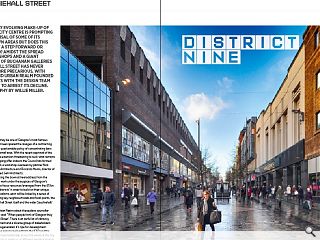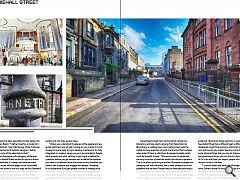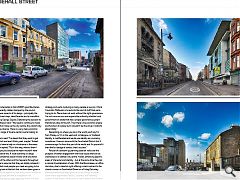Sauchiehall Street
15 Apr 2015
The rapidly evolving make-up of Glasgow city centre is prompting a reappraisal of some of its best known areas but does this represent a step forward or backward? Amidst the spread of pound shops and a giant extension of Buchanan Galleries Sauchiehall Street has never looked more precarious. With that in mind Urban Realm pounded the streets with the design team appointed to arrest its decline. Photography by Willie Miller.
Sauchiehall Street may be one of Glasgow’s most famous streets but it hasn’t been spared the ravages of a contracting retail base and the questionable policy of concentrating bars and clubs within a small area. With the recent approval of the Buchanan Galleries extension threatening to suck what remains of the streets shopping offer indoors the Council has formed We Are Sauchiehall, a workshop overseen by planner Nick Wright, Ice Cream Architecture and Riccardo Marini, director of Copenghagen based Gehl Architects.Tasked with lifting the down at heel address from the doldrums they will work under the auspices of Glasgow’s Districts Strategy to focus resources leveraged from the £1.1bn City Deal on nine ‘districts’ in order to build on their unique character and specialisms, each will be linked by a series of ‘avenues’ connecting key neighbourhoods and focal points, the first being Sauchiehall Street itself and the wider Sauchiehall/Garnethill district.
Speaking to Urban Realm about these plans councillor Gordon Mathieson said: “When people think of Glasgow they say ’oh Sauchiehall Street’. There is an awful lot of vibrancy about it at the moment and a diverse group of stakeholders but it needs to be regenerated, it’s ripe for development. We want to take the lessons learned from the IFSD and the Merchant City then look holistically across the whole of the city recognising that a city is made up of different neighbourhoods, each with its own character.”
To that end Marini has been appointed to help deliver this vision, he told Urban Realm: “I define myself as a modernist, I trained at the Mackintosh, I love Villa Savoye. I think Corbusier was a fucked up planner but a fantastic designer. I define myself in terms of some of the ideas behind that.”
Commenting on the unique cultural legacy of the area Marini added: “Sauchiehall Street has had its ups and downs. It was a fantastic retail area, it’s always had entertainment. Although we have issues with the edges of the Sauchiehall District, a planner has drawn a line on a map, we find Garnethill to be really interesting as a receptor of waves of culture that came into Scotland from Eastern Europe, Italy, the Indian subcontinent and then China. All these waves of immigration have come in, they’ve been assimilated by the city and have left evidence of who they are and were.
“Unless you understand the place and the people and you evolve with them you will get it wrong, as you impose. It’s a bit cheesy but we’re really trying to develop mechanisms for fully integrated co-creation, where we go in, as consultants. People want answers and what we’ll say is you’ve got to define the questions before you get answers and to define the question you need to understand what the issues are and therefore you need to talk to people and engage with people. Ultimately, In our experience if you get people involved in making value judgements about their future the decision making process is far better. Instead of giving fish to starving people you are giving them a fishing rod and teach them how to fish, you are then redundant.”
Copenhagen based Gehl use the Danish capital as a laboratory and take clients ranging from Kazakhstan to Bloomberg on walking tours, even getting them onto the saddle to show examples of good practice but Marini rankles when asked if there is a Northern European template which could be brought to bear: “We work across the globe and are very conscious of what we would call cultural imperialism. This is not about producing a northern European example and stamping it all over the world, that’s what created a lot of the problems that we have. People need to make decisions about their own place, not everything is appropriate everywhere.”
A common refrain heard by Marini is for Sauchiehall Street to be brought up to spec with the more illustrious Buchanan Street but this idea is dismissed as ‘totally inappropriate’. Marini explained: “Buchanan Street performs in a particular way, Sauchiehall Street has a different beat, a different energy. It’s developed a night time economy which has its pros and its cons but how do you make it become more of itself? There are some physical things that you can do, there are some logistical and governance things you can do and critically I think a lot of it’s to do with how you respect people who have made a decision to live in the area.
“I could sit down and write a list of things that need to be done. Some of those I’m arrogant enough to know would be of relevance to the citizens and the traders and the politicians but I’m not going to do that because I want this to come from the other side, I want participants themselves to have this conversation.”
One area of consternation is that of BDPs giant Buchanan Galleries project, recently rubber stamped by the council despite concerns over aspects of its design - principally the loss of Buchanan Street steps, dead facades and a monolithic car park overlooking George Square. Defending the decision to grant approval Mathieson said: “We need to continue to invest in all the sectors which make up the city centre. Any vibrant city centre is going to be diverse. There is a very clear economic strategy about the range of diverse sectors we’re looking to promote.”
For his part Marini said: “I’ve heard that they want to get rid of the steps and at one level I think, yeah, maybe.” Asked whether the Council were a help or a hindrance in the areas regeneration Marini replied; “Put it this way, without them I wouldn’t be talking to you because the team wouldn’t have been taken on to look at this. A local authority is a large bureaucracy that sometimes doesn’t know what one hand is doing in respect of the other and this happens throughout the world, therefore to assume that they are totally coherent I think is assuming that most people you meet are going to be coherent. I can only look at the fact that we have been given a commission and a lot of support to look at this which is difficult for a local authority because there is a degree of risk.
“We’re not saying here’s a draft report go away and read it and comment on it. We’re going to co-create a regeneration strategy and we’re involving as many people as we can. I think Councillor Matheson is tuned into the kind of stuff that we’re trying to do. Place does not exist without the right governance. I’ve not come across one responsible authority whether local government or estate that has a proper governance system that allows place to flourish. Then there’s the economic engine and function of a place but it shouldn’t be the driver, it distorts place totally.”
Depending on where you are in the world you’ll say I’m from Paisley, or I’m in the west end, or Glasgow, or Scotland. Identity is multifaceted and we do use identity as a currency sometimes. I have an issue with the Sauchiehall District but if someone says I’m from this part of the world and I’m proud of it then that’s a badge of honour, that’s success.”
Perusal of a bottom up planning solution holds out the prospect of better engagement with local issues that can be overlooked in a blanket ‘city centre’ model, enhancing specific areas of character and identity - but at the same time they risk a compartmentalisation of uses. With the Broomielaw, an office dormitory that is dead at night offering a stark contrast to the chaotic scenes on Sauchiehall Street on a Friday/Saturday evening there are perhaps grounds to mix things up rather more than a regimented ‘leisure’, ‘business’ and ‘learning’ quarter model allows. Particularly as retail retreats ever further toward the central core.
|
|
Read next: Diverless Cars: Highway to Hal
Read previous: Kirkcaldy: Flour Power
Back to April 2015
Browse Features Archive
Search
News
For more news from the industry visit our News section.
Features & Reports
For more information from the industry visit our Features & Reports section.





